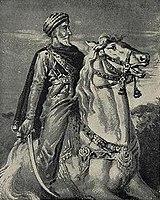Hasan-i Sabbah
| Hassan-e Sabbah | |
|---|---|
 |
|
| Title | Mawla of Alamut |
| Born | circa 1034, Qom, Persia |
| Died | 12 June 1124 (26 Rabi'o-Saani 518), Persia |
| Religion | Islam |
| Jurisprudence | Islam |
| Main interest(s) | Islamic theology, Islamic jurisprudence, Islamic law |
|
Influenced
|
|
Hassan-e Sabbāh (mistakenly Hassan-i Sabbāh Persian: حسن صباح Hasan-e Sabbāh) or Hassan al-Sabbāh (Arabic: حسن الصباح Ḥasan aṣ-Ṣabbāḥ) (circa 1034-1124) was a Nizārī Ismā‘īlī missionary who converted a community in the late 11th century in the heart of the Alborz Mountains of northern Persia. He later seized a mountain fortress called Alamut. He founded a group of fedayeen whose members are often referred to as the Hashshashin, or "Assassins".
Hassan is thought to have written an autobiography, which did not survive but seems to underlie the first part of an anonymous Isma'ili biography entitled Sargozasht-e Seyyednā (Persian: سرگذشت سیدنا). The latter is known only from quotations made by later Persian authors. Hassan also wrote a treatise, in Persian, on the doctrine of ta'līm, called, al-Fusul al-arba'a The text is no longer in existence, but fragments are cited or paraphrased by al-Shahrastānī and several Persian historians.
The possibly autobiographical information found in Sargozasht-i Seyyednā is the main source for Hassan's background and early life. According to this, Hassan-e Sabbāh was born in the city of Qom (Iran) in the 1050s to an family of Twelver Shī‘ah. His father claimed Yemenite origins, who left the Sawād of Kufa hej (modern Iraq) to settle in the (predominantly Shi'a) town of Qom.
Early in his life, his family moved to Rayy. Rayy was a city that had a history of radical Islamic thought since the 9th century, with Hamdan Qarmaṭ as one of its teachers.
It was in this religious centre that Hassan developed a keen interest in metaphysical matters and adhered to the Twelver code of instruction. During the day he studied at home, and mastered palmistry, languages, philosophy, astronomy and mathematics (especially geometry).
...
Wikipedia
